 |
|
|
|
|
|
Symbols of Folk-Architecture of the Island Lesvos: Residential Chimneys by Makis Axiotis [translation and introduction by Mary Papoutsy] |
|
Introduction On behalf of Hellenic Historical and Genealogical Association, I would like to introduce readers to the works of Makis Axiotis. A retired physician with a lifelong interest in history, nature, and archaeology, his works in recent years have become invaluable reference tools for island history. There cannot be a corner of Lesvos that he hasn't visited and observed. His interest in local history is unquenchable, making him a prolific author. Among his many works are a pair of volumes titled Perpantontas te Lesbo: topographia, istoria, archaiologia [Walking about Lesvos: Topography, History, and Archaeology] in which he recounts the island's history and draws archaeological and cultural features seen all over it. Other wonderful recent works, some of which are available on Amazon.com, are his book on watermills of Lesvos, Ydromyloi tis Lesvou [Watermills of Lesvos], and in 2011 his magisterial tome (authored together with his son, Vangelis) Fyta tis Elladas. I erevna sti Lesvo. Votaniki - Chriseis - Toxikotita [Plants of Greece. A Study of Lesvos. Botany - Applications - Toxicity]. His knowledge of Lesvos is encyclopedic and so I hail his periodic articles in local newspapers for new and fascinating gems of Mytilenian history. As I browsed in a bookstore earlier this week, I spotted a copy of his article reprint on the chimneys of the island and snapped it up immediately. While the objects of his keen observation in this piece are unique construction techniques of local artisans, the overall analysis has general application to Neo-Hellenic history and considerable comparative value for other areas of Greece. Perhaps his discussion of these Mytilenian techniques will spur additional studies. What makes Lesvos a particularly good study for Greek history is that it has not experienced the same degree of urban sprawl and commercialization as other places in the country. There are preserved many aspects of local culture and history, in addition to the exquisite unspoiled natural countryside and variety of habitats for flora and fauna. Lesvos even boasts a world-class petrified forest park and numerous thermal springs, testimony to their volcanic origins. Most of it is indeed as ancient writers have described it, quite a rich bucolic setting. In this translation below, I have tried to preserve as much of the writer's style as possible, adding information in brackets only where I felt that a non-local audience might need it. Axiotis originally drew 5 plates of chimneys, each plate averaging about 10 different sketches of chimneys. For our readers I have adapted the plates for Internet use, including renumbering the first plate.Text in parenthesis belongs to Axiotis, while brackets enclose my additions or explanations. The original title of his article was "Symbol in Popular Architecture of the Island. Chimneys of Houses on Lesvos" which I altered slightly for our readers. The pamphlet which I purchased apparently was a reprint from "Epikoinonia Aigaiou A.E."--Mary Papoutsy |
|
Symbols of Folk-Architecture of the Island Lesvos: Residential Chimneys The use of fire extends back indefinitely into the depths of pre-history. Perhaps even before man created his first tool, he had enjoyed the nature of fire. He used flint and wood to keep it always near him. Evidence of it is found on the floors and ceilings of caves where he lived. The suffering of [mythological] Prometheus is tied to the significance of this human achievement, which was considered a "gift from the gods." The "holy fire" burned lime in the hearths of homes and temples of antiquity in honor of the goddess Hestia. The first hearths found in prehistoric homes were "circular hearths" and were built in the middle of the rooms, patterned after their forerunner. We see similar hearths in Mycenaean palaces, like the one at Pylos (Ano Englianou hill) where its decoration has amazingly been preserved. Four columns around it support the roof, in the middle of which was a square "opening" for the smoke. This is our first chimney. These "holes" in the top of roofs, appear very handsome (round) in sample earthen houses found at various excavations of prehistoric homes (Chaironeia, Myrrini in Karditsa, etc.). The ancient Romans built intricate chimneys because they had a heating system with circulating warm air. Nevertheless the typical precursors of our modern chimneys were developed during the Middle Ages in northern Europe. In the 16th and 17th centuries we have tall, ornately adorned chimneys. Here at Lesvos wood was a plentiful fuel for heating and cooking. The "hearth," an integral part of the house, was often decorated intricately, resulting in this document of study of folk-architecture, because the whole family gathered around the hearth. In country mansions, exclusively as indoor heat (together with braziers), hearths were found in many rooms. That's why the chimney (known by several Greek terms) was an indispensable addition to every roof. The folk- or country-builders of houses in villages, and also the architects of large country-mansions, considered the addition as part of the aesthetic appearance of the house, apart from the technical details of his work. For that reason we see representative symbols of each technician which we can say differ from village to village. Sketches of these works are presented below, the results of extensive hiking through many villages of the island. |
|
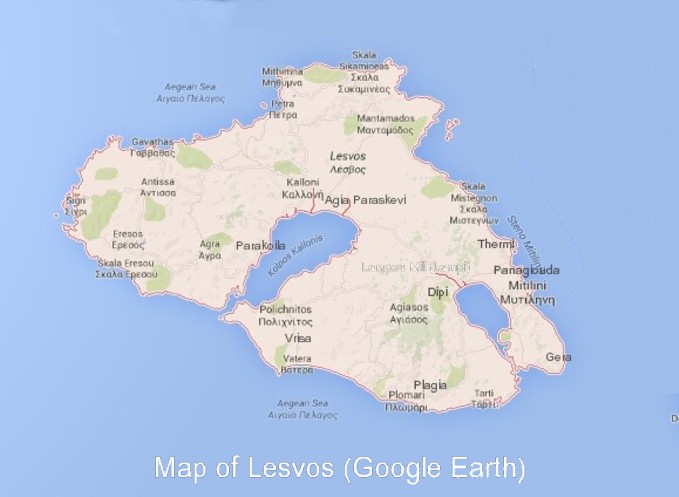 Map of Lesvos (from Google Earth) |
|
| The ancient Romans built intricate chimneys because they had a heating system with circulating warm air. Nevertheless the typical precursors of our modern chimneys were developed during the Middle Ages in northern Europe. In the 16th and 17th centuries we have tall, ornately adorned chimneys. Here at Lesvos wood was a plentiful fuel for heating and cooking. The "hearth," an integral part of the house, was often decorated intricately, resulting in this document of study of folk-architecture, because the whole family gathered around the hearth. In country mansions, exclusively as indoor heat (together with braziers), hearths were found in many rooms. That's why the chimney (known by several Greek terms) was an indispensable addition to every roof. The folk- or country-builders of houses in villages, and also the architects of large country-mansions, considered the addition as part of the aesthetic appearance of the house, apart from the technical details of his work. For that reason we see representative symbols of each technician which we can say differ from village to village. Sketches of these works are presented below, the results of extensive hiking through many villages of the island. Technically, the chimney is made up of a stack and cap so that water won't enter. The stack is typically of square profile. There exist also rectangular stacks of large chimneys, and even more rarely there are circular ones as seen in Figure 6 at Agiasso. [The original article contained a reference here to Figure 4 as well, but there were no circular shapes in the drawings of Figure 4.] |
|
Construction material was kiln-fired brick, but occasionally also stone and lime-mortar were used. The bricks usually were set in rows "upright" (as in Figure 5, diagrams 1, 2, 5, and 12) or "slanting" (as in Figure 6, diagrams 2, 3, and 4). Covering this base material was a veneer of lime-mortar, but in quite a few types the brick was left without veneer as part of the aesthetic scheme of the chimney. On some homes, concavities in the brick bore the initials of the builder and its chiaroscuro gave a special charm to the construction. The removal of one brick near the top of the stack in quite a few chimneys created an opening for better draft. The cap is the top part of the chimney. Here the craftsman focused his artistry, giving it his representative stamp. We discern three basic forms of chimneys in accordance with the construction materials: iron, brick, and stone slabs. Iron The iron chimney is made of square sheets (rarely of round pieces) whose caps are serrated, sometimes plain, other times ornate.* At Agiassos one basic type of chimney is made of unveneered brick and iron whose serration above and below [the plane of the plate] alternates (Figure 6, diagram 1). The iron is supported at the edges of the chimney stack with four iron columns at the corners. At Gera where we have the most beautiful examples of all the villages, there are also weather-vanes. Above the iron cap there are four metal bands from the corners that join together elaborately in the center with coils at their tips. Atop them on a vertical axis is a metal weather-vane in the shape of a bird (Figure 1), a Greek flag (Figure 2, diagrams 1 and 6), a flag with the initials of the owner (Figure 2, diagrams 7, 8, and 9), of a fish (Figure 2, diagram 5), airplane (Figure 2, diagrams 10, 11, and 12) of a hunter (Figure 2, diagram 16), archery bow (Figure 2, diagram 14), and others. In this village chimneys are manufactured with stone and brick, but veneered with lime-mortar. At Plomari some improvised chimneys had for caps a container with openings on the sides (Figure 6, diagram 9). And finally, the elaborate chimney caps of country-mansions should be mentioned, both in the capital [city of Mytilene] and in the villages. These are caps made of iron in various shapes. But they are composite constructions, some created by craftsmen, others made commercially (Figure 6, diagrams 5 and 6). |
|
|
Brick and Ceramic At Mantamado the basic type of chimney is of unveneered brick with two wide strips about the rim [constituting a type of corbelling]. These two strips are made of plain brick (Figure 3, diagram 4) or of a slanting piece of brick (Figure 3, diagram 5). At Agia Paraskevi, chimneys bear the trait of concavities in the bricks with [builder's] initials on the exterior, but the caps are of varying shapes. Four or more bricks support the cap adorned with various earthenware creations (Figure 3, diagrams 1 and 2). At Polichnito, a thin earthenware slab, supported by four upright bricks, bears a pyramidal tip made of lime-mortar, which in turn ends in another ornament of lime (Figure 3, diagrams 6 and 7). At Vrisa, chimneys are constructed of brick, many times with wider strips on the top, formed as a cone with truncated apex. These decorated tips are ceramic tiles placed with the concave curves facing inward and joined by lime-mortar (Figure 4, diagrams 4 and 5). At Parakoila there are very beautiful and uniformly made chimneys. Constructed of brick, above them are pointed boxes, each one of which was laid out covering the other as though overlapping ceramic roof-tiles. The top has the shape of a dome [literally here "tholos"], made out of lime-mortar and has a bottle or a vendouza [small stout glass used for cupping].** Plagia has chimneys fashioned with bricks and veneer. We also have here very beautiful and characteristic caps. The cap-boxes are created by upright bricks and their upper parts are either straight or arched from the placement of a ceramic roof-tile. Above the cap-boxes there are gables made from ceramic roof-tile pieces (one on each side). The tip is made out of lime-mortar and small ceramic roof-tile pieces and it ends in a glass cover (bottle) or in an ornament made of lime-mortar (spheres, one above the other), which we often find on pediments (Figure 4, diagrams 6, 7, 8, and 9). At Gera (Figure 3, diagrams 9, 10, 11) and Dip on the bay [of Gera] (Figure 3, diagram 8), I spotted one other construction which had above the columns of the cap-box (upright bricks or small bricks) a square metal frame that supported yet another form, a ceramic roof-tile used to create a curved arch and a pyramidal apex. Without that additional frame [seen at Gera and Dipi], we saw at the top of a cap-box at Panagiouda 4 earthenware creations (Figure 3, diagram 3). At Plomari earthenware pipes protrude from the side (Figure 6, diagram 2), while at Agiasso, they emerge from the top (Figure 6, diagram 3). One other large group of chimneys very common on the island are those capped by ceramic roof-tiles. Arranged slanting, they form a three-cornered opening. Most of the villages of the island have this type of cap, including Agiassos (the next largest group there after the iron chimneys), and it is the chief form at Plomari and for small rustic homes. One characteristic type with 4 openings we see at Plomari (Figure 5, diagram 1, 2, 3) from where originates also the double chimney (Figure 5, diagram 4). We see similar ones at Thermi (Figure 5, diagram 7), Agia Paraskevi (Figure 5, diagram 8), Mantamado (Figure 5, diagrams 5 and 6), Plagia with the double cap-box (Figure 5, diagram 10) and the high stack with its false cap-boxes (Figure 5, diagram 11), the water-mills of Lampis *** (Figure 5, diagram 12), and the small but curious chimney of diagram 9 (Figure 5) from Agia Paraskevi. We see here [in these described chimneys] the work of folk-artisans able to construct so many shapes. Chimneys of Tiny Country Cottages among Olive-Groves Simple and picturesque figures amid olive groves are the small doll-house-like cottages, known as "damia." Their chimneys are large enough, connected to the entire building, and are round, made of small rocks, pieces of ceramic roof-tile, brick and liberal amounts of lime-mortar. Small bricks or stones support the top, a flat stone slab, a piece of slate from the surrounding area (Figure 6, diagram 8). Two pieces of green slate form a chimney top at Plomari (Figure 6, diagram 9), while at Agiassos 4 small bricks support the stone slab of a wooden house at the entrance to the town. Surely there are thousands more combinations that the artistry of the folk-craftsman created from simple materials he had at hand. Unfortunately, with new homes, apart from a few specific instances counted on one hand, chimneys are made impersonally and of inelegant manufacture. The chimneys [described here] are witnesses to a by-gone era. Placing one's own stamp upon the chimney of a house presupposes love for one's work and a taste for beauty, something lacking today. Mytilene, 21 September 1992 [Reprint from the 24th volume of "Lesviakon" Bulletin of the Association of Lesviot Studies.] |
|
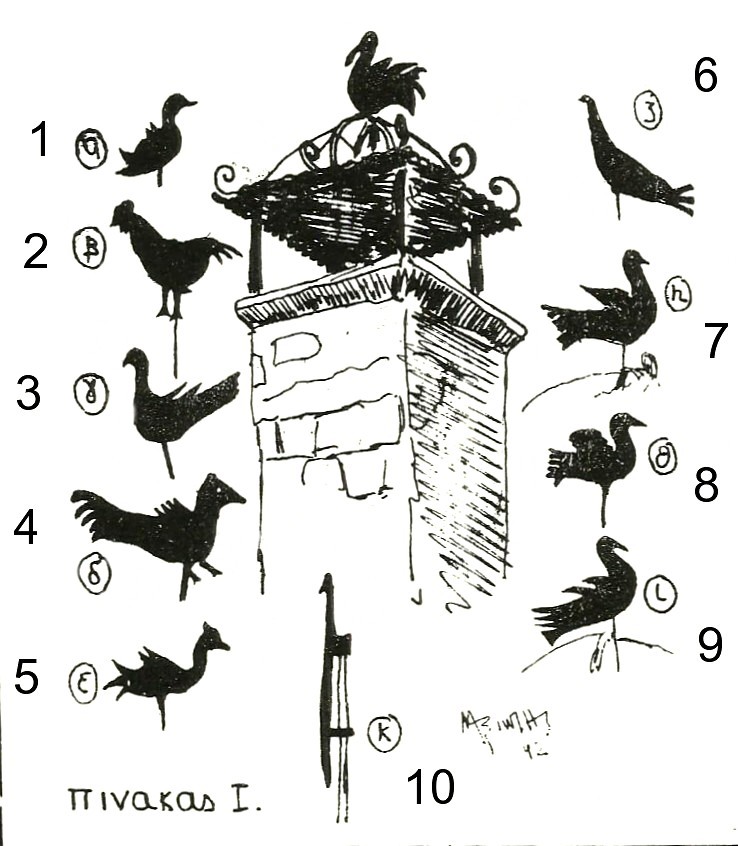 |
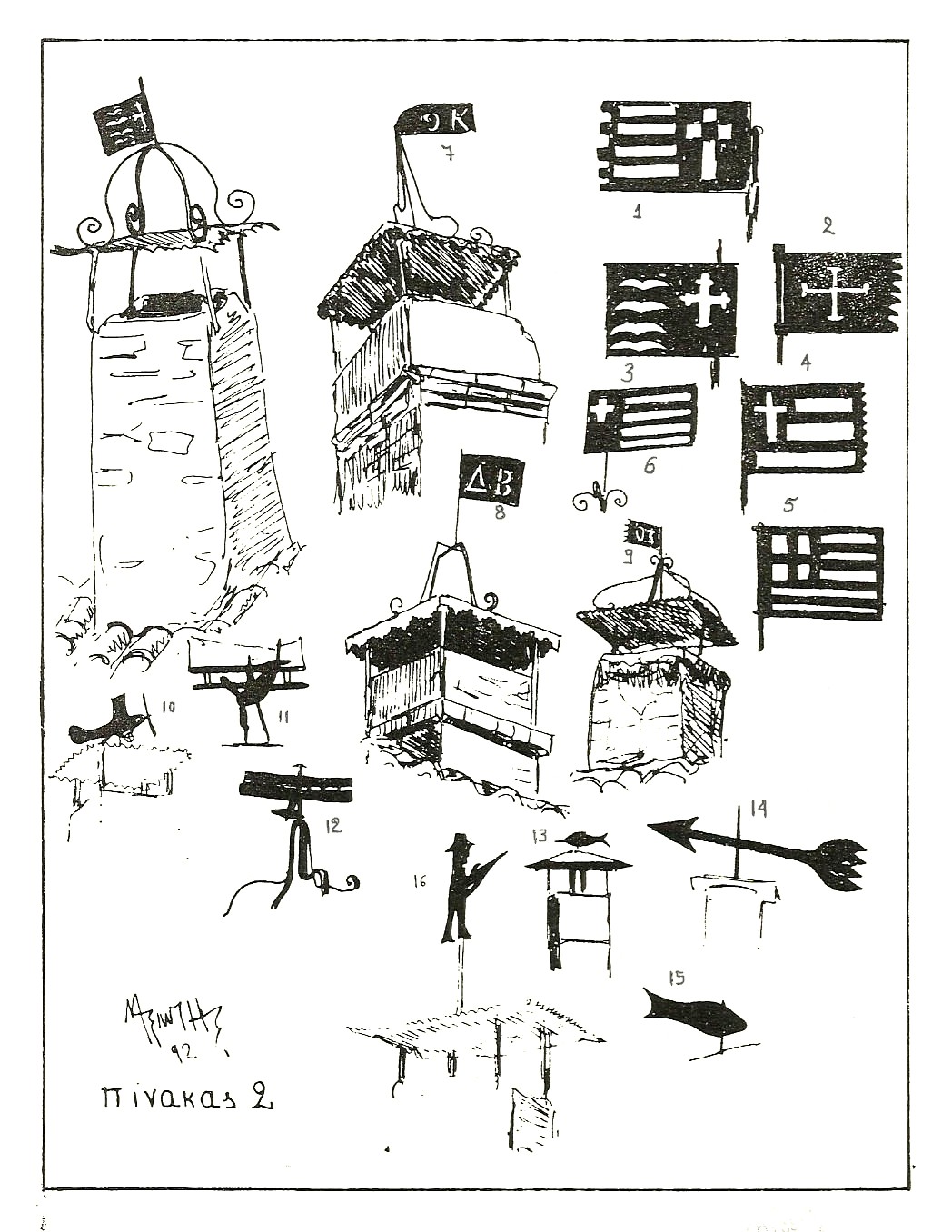 |
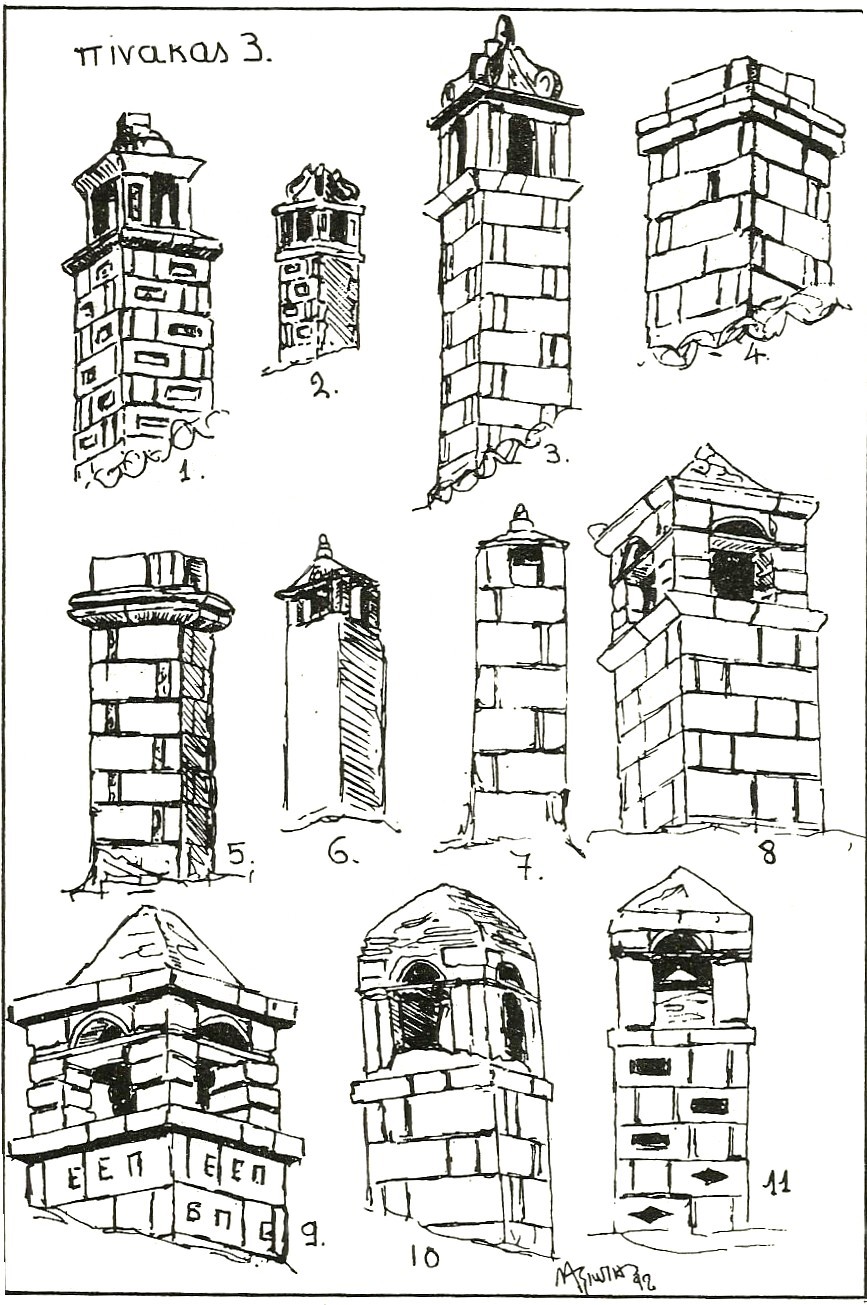 |
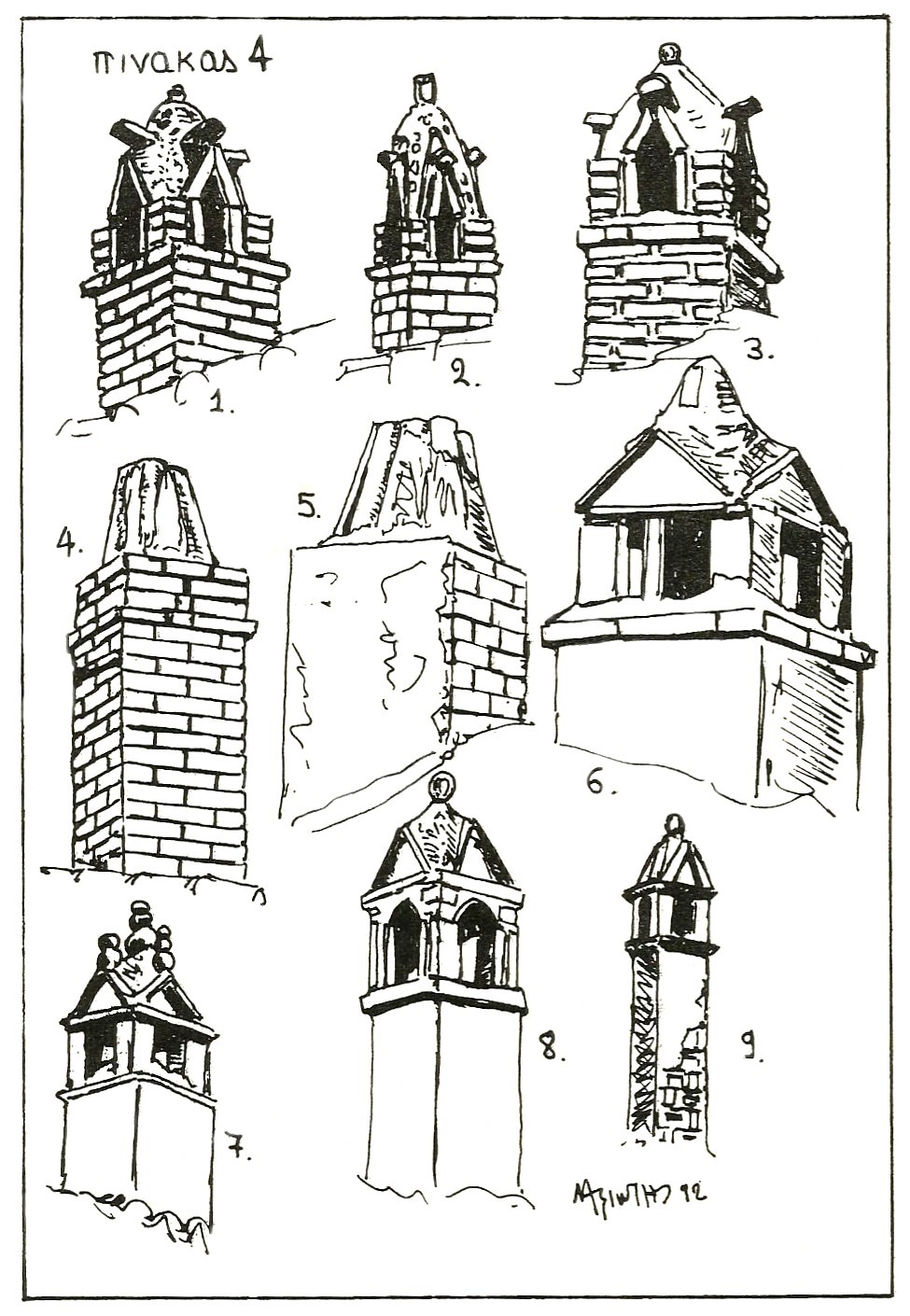 |
 |
 |
| * It is unclear here whether or not Axiotis means that the stacks of the chimneys themselves can be made of sheets of metal or just the caps, as seems more likely. ** The Greek term, "vendouza," refers to a cupping glass, but Axiotis had also enclosed the phrase "lightning rod" within parenthesis following "vendouza." A quick consulation with the voluminous lexicon by Babinioti, Lexico tis Neas Ellinikis Glossas, sheds no light on the appearance of "lightning rod" in connection with "vendouza." Either this was a publication error, or a Lesviot colloquial expression which has not found its way into the standard reference works. I chose to omit "(lightning rod)" from the body of the text of the translation. *** This town must be a contraction of the name "Lampou Mili." |
|
|
(Posted 28 July 2016) HCS readers can view other genealogical articles and releases in our extensive, permanent archives at the URL http://www.hellenicomserve.com/archivegenealogy.html. For more information about genealogical methodology, especially in researching Hellenic ancestry, see especially the main genealogy page or the section about Hellenic Historical and Genealogical Association at the URL http://www.helleniccomserve.com/hhga.html. |
|
|
|
|
|
2000 © Hellenic Communication Service, L.L.C. All Rights Reserved.
http://www.HellenicComServe.com |
|

